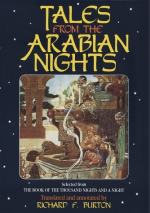P. 104, note 1.—Apropos of the importance of “three days,” I may refer to the “three days and three nights” which Christ is commonly said to have passed in the tomb, and I believe that some mystics assert that three days is the usual period required by a man to recover consciousness after death.
Pp. 106, 107.—These worked lions recall the exhibition of power made by Abu Mohammed hight Lazybones (No. 37; Nights, iv., p. 165). Their Oriental prototypes are probably the lions and eagles with which the Jinn ornamented the throne of Solomon. In the West, we meet with Southey’s amusing legend of the Pious Painter:
“‘Help,
help, Blessed Mary,’ he cried in alarm,
As
the scaffold sunk under his feet;
From
the canvass the Virgin extended her arm;
She
caught the good Painter; she saved him from harm;
There
were hundreds who saw in the street.”
The enchanted palaces of the Firm Island, with their prodigies of the Hart and the Dogs, &c., may also be mentioned (Amadis of Gaul, book ii., chap. 21, &c.).
Pp. 107, 108.—Stories of changed sex are not uncommon in Eastern and classical mythology and folk-lore; usually, as in this instance, the change of a man into a woman, although it is the converse (apparent, of course) which we meet with occasionally in modern medical books.
In the Nights, &c., we have the story of the Enchanted Spring (No. 135j) in the great Sindibad cyclus (Nights, vi., pp. 145-150), and Lane (Modern Egyptians, chap. xxv.) relates a story which he heard in Cairo more resembling that of the transformed Wazir. In classical legend we have the stories of Tiresias, Caeneus, and Iphis. Turning to India, we meet with the prototype of Caeneus in Amba, who was reincarnated as Sikhandin, in order to avenge herself on Bhishma, and subsequently exchanged her sex with a Yaksha, and became a great warrior (Mahabharata Udyoga-Parva, 5942-7057). Some of the versions of the Enchanted Spring represent the Prince as recovering his sex by an exchange with a demon, thus showing a transition from the story of Sikhandin to later replicas. There is also a story of changed sex in the Hindi Baital Pachisi; and no doubt many others might be quoted.
History of What Befel the Fowl-let
with the Fowler (Pp.
119-128).
One of the most curious stories relative to the escape of a captured prey is to be found in the 5th Canto of the Finnish Kalevala. Vainaimoinen, the old minstrel, is fishing in the lake where his love, Aino, has drowned herself, because she would not marry an old man. He hooks a salmon of very peculiar appearance, and while he is speculating about cutting it up and cooking it, it leaps from the boat into the water, and then reproaches him with his folly, telling him that it is Aino (now transformed into a water-nymph) who threw herself in his way to be his life-companion, but that owing to his folly in proposing to eat her, he has now lost her for ever. Hereupon she disappears, and all his efforts to rediscover her are fruitless.




